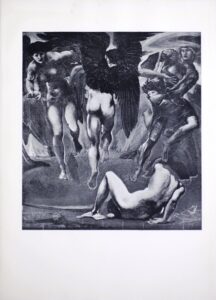PAG1-burnejones-perseus-jpg
Also known as “The Death of Medusa II,” this painting, reproduced in halftone, is from a series of ten commissioned in 1875 by Sir Arthur Balfour for his music room. Displayed in portrait orientation, this image depicts the moment after Perseus cuts off the head of the Medusa. At the centre of the image is the back of one of Medusa’s two winged sisters. We see her lower body and dark wings spread out as she takes flight to find her sister’s murderer.
